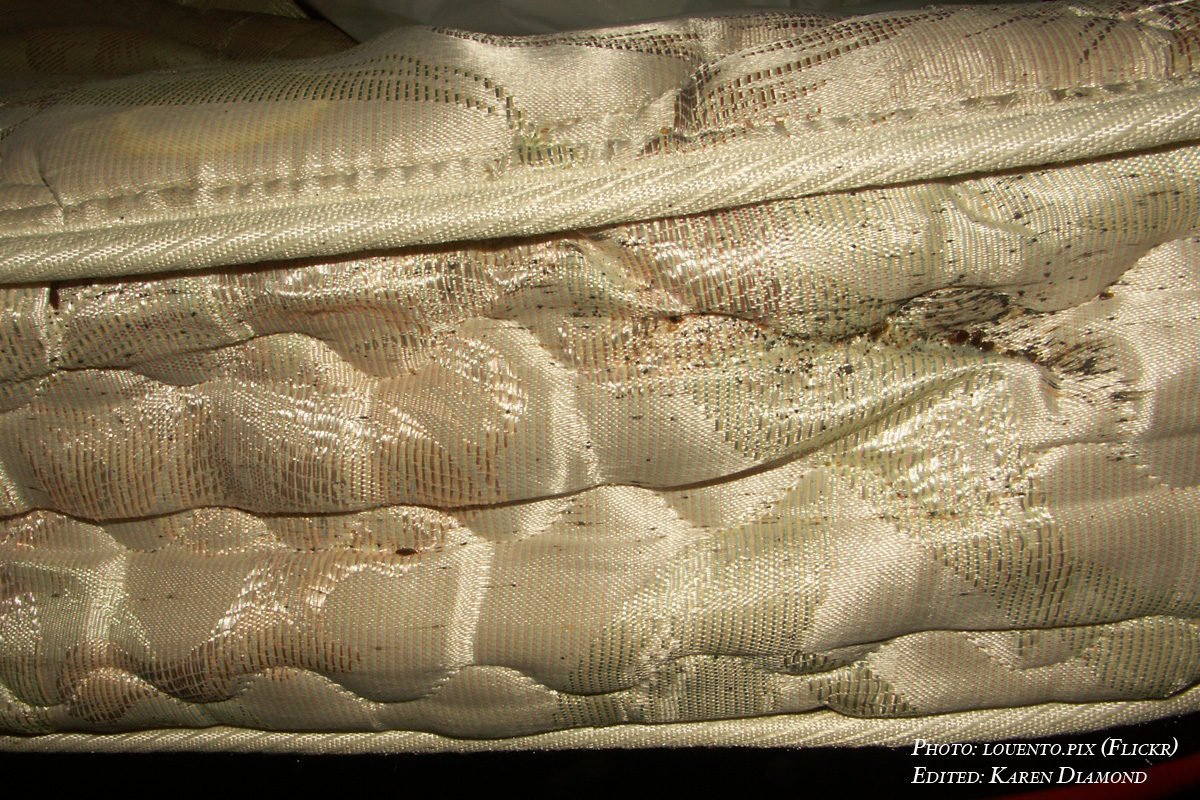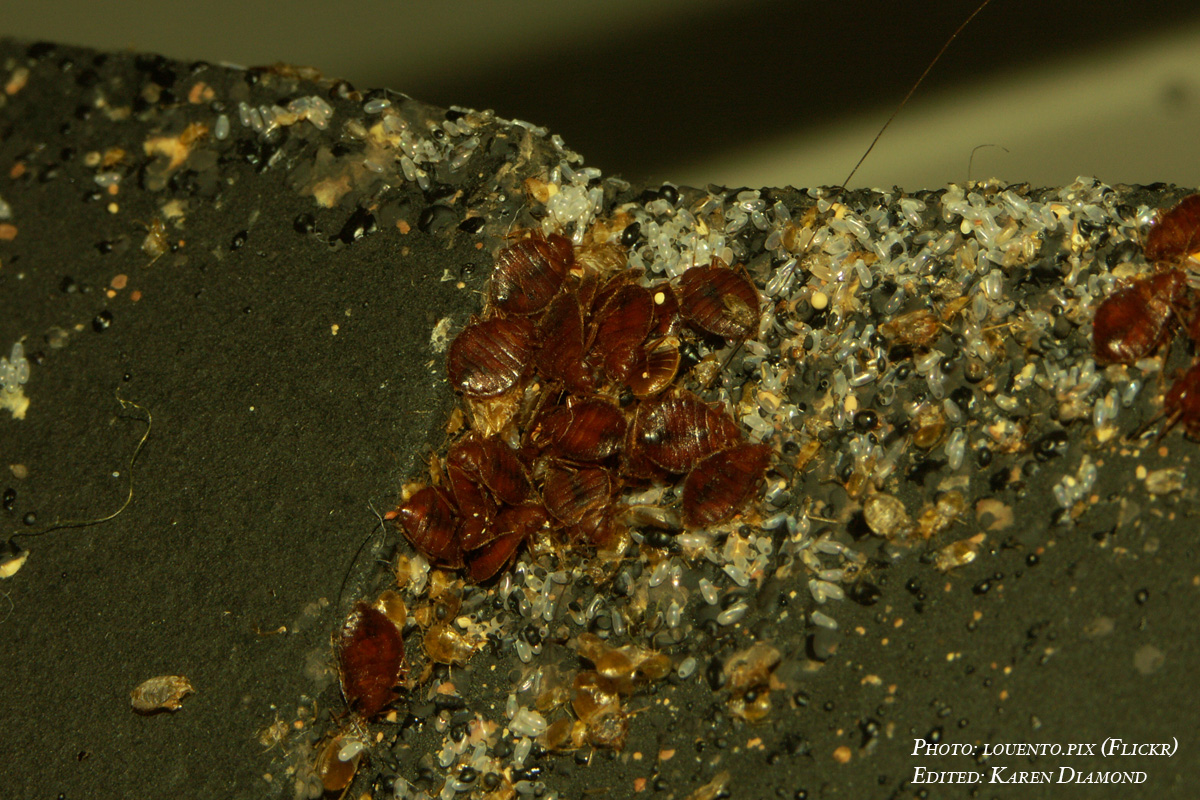Bed bugs are nasty parasites that require a blood meal to survive. They have a life span of about a year, and they are brownish red in color.
They are so hard to eliminate as they are incredibly persistent and skillful at hiding. Regardless of how well they hide, there are certain signs that certainly give them away:

- Bed Bugs: Infant about size of pinhead while the adult is about the size of an apple seed. (#1)
- Black Dots: Which are actually digested blood (aka feces). (#2)
- Pearly Eggs: Oval shaped, size of a pinhead. (#3)
- Bug Skins: When molting into adults, they leave behind their skins. (#4)
- Blood Stains: Little rust spots found on sheets, pillowcases, pajamas, etc...
- Bites: Itchy bug bites on the body, usually next to each other.
This evidence can be found along the seams and edges of mattresses and box springs as well as the headboard and footboard. However, bed bugs are no longer found in the bedroom! They migrate to other rooms such as the living room, home office, etc. They can even "hitchhike" and be moved to other places. They can be transported by luggage, clothing, beds, furniture, and other items. Secondhand beds, couches, etc. is another way that bugs can be transported.
Bed bugs are not only found at home. There is a higher risk for those places that have a larger turnover of occupants such as hotels and apartments. Recently, they have been found in movie theaters, hotels, office buildings, etc.
Bed Bugs can be challenging to eradicate. According to the University of California stated, "The best approach is to combine chemical and non chemical tactics with increased sanitation and habitat modification practices." Calling a professionally trained extermination company is the most effective solution in eradicating bed bugs.
Bug Cops Pest Control has a TACTICAL PLAN of ACTION that has proven to successfully eradicate bed bugs. It's time for some serious action now!
WHAT TO EXPECT?
The first step is to call 904.264.3308 to schedule your beg bug inspection.
Then, we will begin treatment immediately.
Bed bugs are not typically eliminated in one treatment, it may require two treatments. After treatment, we will return for an inspection. At that time, we will know if additional treatment is required at no additional cost. It all depends upon the level of infestation and how complicated the situation is.
How to Avoid Bed Bugs?
If you are sleeping away from home, then the first thing to do is to a thorough bed bug inspection. But, until you do that - Leave your luggage in the bathroom.
"Bedbugs are least likely to be found in the bathroom," says Missy Henriksen, vice president of public affairs for the National Pest Management Association. "They don't like the tile floors and there aren't as many hiding places. They like to be closer to where people may be sleeping."
Next, inspect the bed. Pull back the covers and sheets, checking all the way around seams of the mattress and boxspring and even behind the headboard. Be on the look out for blood stains or small black dots.
Then, check your room. Search behind pictures hanging on the walls, under lamps and telephone, and even in books left behind in the drawers or literature. Most bed bugs can be found within 15 feet of a bed. Also, check the cushions of couches and chairs.
Another preventative measure to take is to leave your luggage off the ground. Keep your bags on the desktop, or dresser or even the luggage rack in the room.
If you suspect that there are bed bugs, then move rooms to at least 2 floors away.
WARNING --- Do not scratch your bites, it can leave permanent scars!
The most common symptoms of bed bug bites include:
- itching on the skin
- small red bumps that, at times, occur in lines or zigzags pattern on the legs or arms
- skin eruptions that might ooze fuzz before healing
Keep in mind though, that people can react differently to bed bug bites. Some people experience no symptoms while others can suffer more drastic allergic reaction like pain and fever-like symptoms.
First thing to do is to clean the skin that is affected with a rash with a mild anti0itch solution. For swelling, itching, and redness, Dr. Axe suggest using a natural antihistamine. Natural treatments for bites include:
- patchouli oil
- cool compresses
- tea tree essential oil: if you have sensitive skin, mix three drops with half-teaspoon of coconut oil to dilute the solution.
If you have a history of strong allergic reaction to bug bites or notice any sign of infection cause from the bed bug bites, it is best to see a doctor.
Source: Babcock, Jillian. “What to Do About Bed Bug Bites.” Dr. Axe, Dr. Axe, 11 July 2018, draxe.com/bed-bug-bites/.
*This should not be construed as medical advise.



